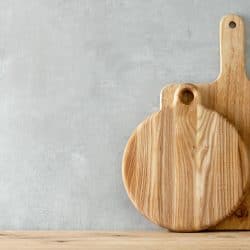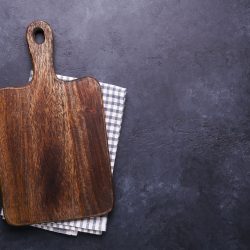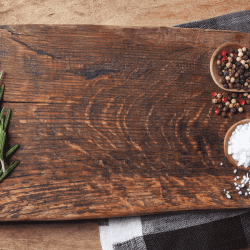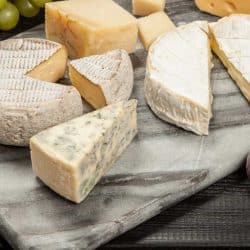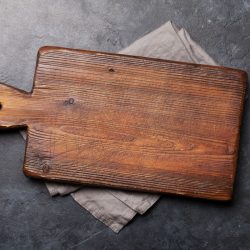Wooden cheese boards need oil to keep them beautiful, but what is the best type of oil to use? You don't want to use anything that you can't put food on. And you don't want to use something that might turn rancid. We've taken the guesswork away and have researched to find out which oils are okay for your wooden cheese board. Let's take a look.
These oils are all suitable for use on wooden cheese boards, as long as they are labeled food grade:
- Mineral oil
- Beeswax
- Refractionated coconut oil
- Carnauba wax
We'll take a look at each of these oils and why they work well for your wooden cheese board. We'll also talk about when you need to oil your cheese board, how you can seal it, what woods are best for cutting boards, and if you need to oil both sides of the board. So please keep reading for all of the answers.
![A selection of English and French cheese on rustic board, What Oil Do You Put On A Wooden Cheese Board? [For Maintenance]](https://kitchenseer.com/wp-content/uploads/2021/06/What-Oil-Do-You-Put-On-A-Wooden-Cheese-Board-667x1000.png)
The Best Oils For Wooden Cheese Boards
Because you're going to be using these boards to serve food, it's super important to use non-toxic, food-safe oils, and that won't go rancid over time. Here are four that will do the trick.
Mineral Oil
Mineral oil is a petroleum-based product, but the FDA approves it for use on serving dishes. It is odorless, flavorless, and prevents water absorption, which is exactly what you need when it comes to your cutting board. You want to protect it from drying out and growing brittle in a way that might allow it to soak up water and get bacteria in the grain. Always be sure to look for food-grade mineral oil for use on cutting boards.
Click here for this on Amazon.
Beeswax
Beeswax is a natural wax produced in the hives of honey bees. You can use beeswax to hydrate, shine, and waterproof a cutting board.
Click here for this beeswax on Amazon.
Refractionated Coconut Oil
The refractionated part of this type of coconut oil is important. Many coconut oils will go rancid, so you don't want those. This type has been steam distilled, making it shelf-stable with a very long life. This is a really awesome oil that you can use on wooden spoons and bowls, as well as your cutting boards and cheese boards.
Click here for this on Amazon.
Carnauba Wax
This wax is derived from Brazilian palm tree leaves. It's known for its glossy finish and extreme water resistance. It's probably best known for its use in some car polishes. But don't use those on your cutting board. Look for it in a food-safe product that can be used safely on your serving piece.
This brand is advertised as great for bamboo service pieces and is a blend of beeswax and carnauba wax. It also contains lemongrass to give it a gorgeous odor.
Click here for this on Amazon.
Other Oils That Are Kind Of Okay
There are a few other oils that you may use in a pinch. However, each of these comes with a word of caution. Tung oil can give a beautiful satin finish, but it is often just one ingredient in a more toxic cocktail. Be sure you use pure tung oil if you're going to use it, but be aware some people have allergies to it. Linseed oil is another oil made from flaxseed. It can work in a pinch but can go rancid over time. Walnut oil is also the same as far as rancidity and also allergens, though it has a lovely smell in the short term.
Do You Need To Oil A Cheese Board Before Using It?
If you've bought a new cheese board that has never been oiled, you'll definitely want to oil it before using it. Oil protects the wood and builds a protective layer on the surface. It also puts a layer of material between the cheese itself and the open grain of the wood. This will help keep your cheese board as clean as possible.
How Do You Seal A Wooden Cheese Board?
Maybe you've picked up an older cheese board at a vintage store, and it's lost its seal. How can you get it back? It's not hard to do. Start with lightweight fine-grit sandpaper and gently sand the entire surface of the board until it feels smooth to the touch. Then use a beeswax and mineral oil combination and rub it into the entire surface of the board. Take a soft cloth and buff it until the mixture is pushed into the grain. Repeat this as long as the wood will absorb the product.
There are great products commercially available that combine wax and oil into one easy-to-apply product. This wood butter is food safe and intended for wooden cutting boards and utensils.
Click here for this on Amazon.
This handy little sponge applicator is great for application and buffing the wax and oil combination into the board.
Click here for this on Amazon.
What Kind Of Wood Is Typically Used For Cheese Boards?
These days, charcuterie boards are all over the Internet, with people competing for the most gorgeous displays of meat and cheese. By far, the favorite type of serving dish is a wooden cheese board. These boards are available in various woods, but the most common wood used for cheese boards are acacia, teak, and bamboo. (We have an in-depth blog post on this here: What Kind of Wood is Used for Cheese and Charcuterie Board?)
Let's look at each type of wood.
Acacia Wood
Acacia wood grows in many locations around the world but is native to Australia. This hardwood is grown specifically for its use in furniture and other applications that need dense, strong wood. The natural wood holds up against pests and funguses making it particularly good for use in cutting boards. It's also lovely with a strong pattern of graining.
Click here for this on Amazon.
Teak Wood
Teak is another tropical hardwood that is dense and long-lasting. Because it retains much of its original oil and rubber, even as it drys, this makes it a valuable wood to use for applications like cutting boards. It's naturally water and fungus-resistant.
Click here for this solid piece of teak cutting board on Amazon.
Bamboo
The other popular wood for use in cheese boards is bamboo. Bamboo is super sustainable as it grows very quickly. However, technically it's not wood. This woody grass has fibers that make it 2-3 times stronger than the average hardwood and significantly lighter. It's also very pretty with its paler wood tone.
This bamboo tray comes with bamboo cutlery. Click here for this on Amazon.
Do You Oil Both Sides Of A Cheese Board?
It is a good idea to oil both sides of your wooden cheese board. Though presumably, you are only serving food off one side of it, both sides will get wet when you wash it. And water can dry out the wood, which is why you should oil it regularly. Of course, you may not need to oil the backside as often as the serving side if you wash it carefully.
Is It Possible To Over-Oil A Cheese Board?
It's not really possible to over-oil a cheese board. Once the wood has soaked up the oil it needs, it simply won't soak anymore up. So though you may use too much, and it may pool on the surface of a fully-oiled board, it won't hurt anything. You'll need to clean up the excess before you use your board. And if you've followed best practices and used food-safe oil, then it won't hurt your cheeses either.
Let The Cheese Tray Shine
Now that you know the best oil for your cheese tray, it's time to get it spiffy. Give it a good coating of oil to preserve its life and let it look beautiful beneath your lighting. Fill it with all of the delicious cheese, fruits, nuts, and meats that you love to serve.
If this article was helpful for you, please check out a few of our others here at KitchenSeer.com below:
What Oil Is Best For Butcher Block Or A Cutting Board?
How Much Do Butcher Block Countertops Cost? [By size, type, grain, and brand]










